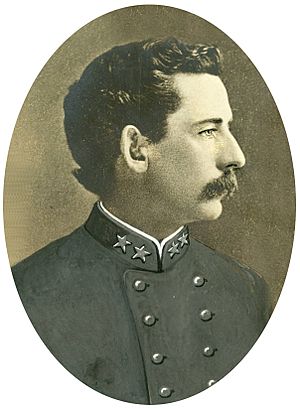R. Preston Chew facts for kids
Quick facts for kids
Roger Preston Chew
|
|
|---|---|
 |
|
| Born | April 9, 1843 Loudoun County, Virginia |
| Died | March 16, 1921 (aged 77) Charles Town, West Virginia |
| Place of burial |
Zion Episcopal Churchyard, Charles Town, West Virginia
|
| Allegiance | |
| Service/ |
|
| Years of service | 1861–65 (CSA) |
| Rank | |
| Commands held | Stuart Horse Artillery |
| Battles/wars | American Civil War |
| Other work | West Virginia Legislature 1882–1888 |
| Signature | |
Roger Preston Chew was an important figure in American history. He was born on April 9, 1843, and passed away on March 16, 1921. During the American Civil War, he was a skilled leader of horse artillery for the Confederate forces. After the war, he became a successful businessman and railroad leader in West Virginia. He also served as a lawmaker in West Virginia.
Roger Chew's Early Life
Roger Chew was born into a well-known family. His birthplace was Loudoun County, Virginia. His father was also named Roger Chew, and his mother was Sarah Aldridge. When Roger was three, his family moved to Charles Town, West Virginia. At that time, Charles Town was part of Virginia.
Roger went to Charles Town Academy. Later, he studied at the Virginia Military Institute. His family owned a historic home called The Hermitage. It was one of the oldest houses in western Virginia.
Roger Chew in the Civil War
When the Civil War began, young Roger Chew quickly formed a group of soldiers. This group was called "Chew's Battery." They were a special type of artillery unit. These soldiers moved their cannons using horses. Chew's Battery became part of the famous Laurel Brigade. This brigade fought under the command of Stonewall Jackson.
Roger and his brother, John A. Chew, fought in all of Jackson's battles. They continued to serve until Jackson's death in May 1863. Roger Chew also led attacks into Union-held areas. These included Middleway, West Virginia, in February 1863. He also led a raid on Charles Town on May 12, 1863.
Even though he was young, Roger Chew was promoted. He became the chief of the cavalry's cannons. He served under General J.E.B. Stuart. Chew then fought in many major battles. These included the Gettysburg Campaign. He also fought in the Wilderness and Spotsylvania Court House. Other battles were Cold Harbor, the Siege of Petersburg, and the Appomattox Campaign.
Life After the War
After the Civil War ended, Roger Chew and his brother Robert worked together. They rebuilt their family farm. In 1871, Roger married Louise Fontaine Washington. She was the daughter of the last owner of Mount Vernon. Her family lived at Blakeley. Roger and Louise had six children. Louise's father, John Augustine Washington, had served with General Lee. He was killed in action in late 1861.
In 1875, Louise Chew bought Blakeley. She purchased it from her uncle, who was having money problems. Louise took care of Blakeley until it was sold in 1892.
Roger Chew started many different businesses. He was the president of the Eagle Manufacturing Company. From 1882 to 1888, he also served in the West Virginia House of Delegates. This is a part of the state government. In 1883, the Shenandoah Valley Railroad built a special track. It was called Chew's Siding. This track led from the main line directly to Chew's business. In 1890, Chew and some business partners started a new company. It was called the Charles Town Mining, Manufacturing, and Improvement Company. Roger Chew became its first president.
Death and Legacy
Roger Chew passed away in Charles Town in 1921. He is buried in the Zion Episcopal Church graveyard. His wife, Louise, who died in 1927, is also buried there. His brother, Robert, who died in 1898, rests there too.

